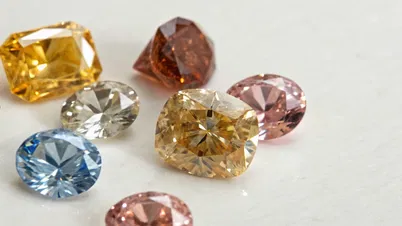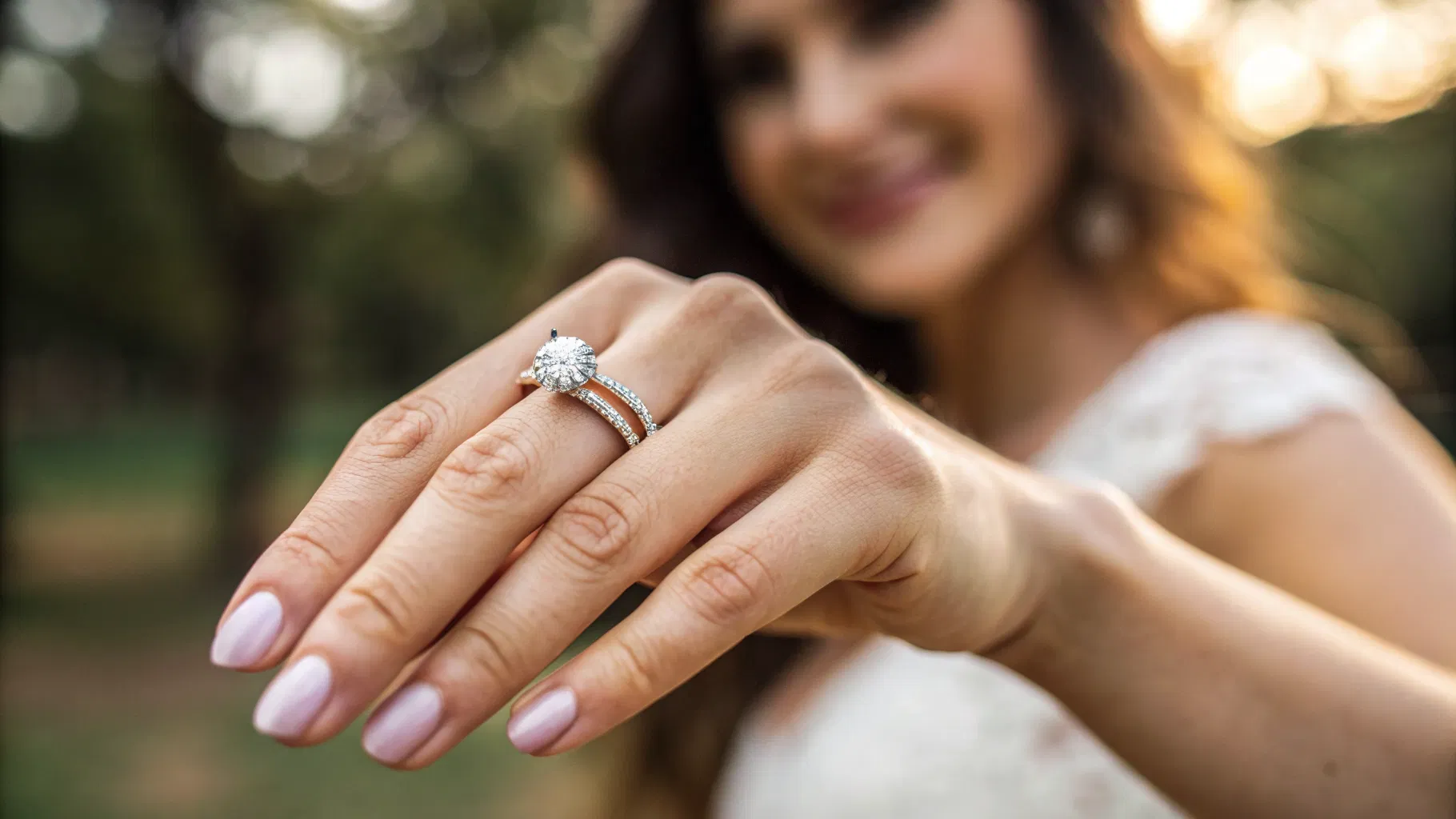
What Colors Can Diamonds Be Naturally? A Comprehensive Exploration
Introduction
Can true luxury also be truly ethical? As consumers become more conscientious about their purchases, the demand for sustainable and unique products has surged. In the realm of fine jewelry, this shift is particularly noticeable as individuals seek pieces that not only sparkle but also tell a story—one that resonates with their values. Are you dreaming of a piece of jewelry that’s as unique as your story? If so, understanding the captivating colors of diamonds can guide you in making an informed choice.
At DiamondsByUK, we are committed to redefining luxury by making sustainable, conflict-free diamond jewelry accessible to all. Our mission extends beyond simply offering beautiful pieces; we strive to educate our customers about the artistry and ethics behind our jewelry. In this blog post, we will explore the diverse colors that diamonds can exhibit naturally, their formation processes, and how these colors affect value. We will also touch upon our customization options, allowing you to design a bespoke piece that is uniquely yours.
The Formation of Diamonds and Their Colors
Diamonds are formed deep within the Earth’s mantle, under extreme conditions of high temperature and pressure. Typically, they are created at depths of around 140 to 190 kilometers below the Earth’s surface over billions of years. The crystalline structure of diamonds is composed of carbon atoms arranged in a tetrahedral lattice, making them the hardest natural material known to man. While pure diamonds are colorless, the presence of various impurities and structural defects during formation can lead to a spectrum of colors.
Chemical Impurities and Structural Defects
The colors in diamonds arise primarily from two factors:
- Chemical Impurities: The introduction of other elements into the diamond's crystal structure can cause distinct colors. For instance:
- Nitrogen: This is the most common impurity found in diamonds and can impart yellow or brown hues.
- Boron: This element gives diamonds a blue color by absorbing yellow light.
- Hydrogen: This can lead to the formation of pink and purple diamonds, especially when structural defects occur.
- Structural Defects: These include distortions in the diamond’s crystal lattice due to extreme pressure, leading to colors such as red and pink.
Understanding these aspects allows us to appreciate the complexity and beauty of naturally colored diamonds, which can take on an array of stunning hues.
The Spectrum of Natural Diamond Colors
Diamonds can naturally occur in a variety of colors, each with its unique charm and story. Below, we explore the most common diamond colors and the science behind their formation.
1. White Diamonds
White diamonds are often considered the classic choice. They are graded on a scale from D (colorless) to Z (light yellow or brown). The presence of nitrogen impurities typically causes the slight coloration in lower-grade diamonds.
2. Yellow Diamonds
Yellow diamonds are the most common colored diamonds. The intensity of their yellow hue can vary based on the amount and arrangement of nitrogen within the crystal lattice. These diamonds can range from a light canary yellow to a deep, rich hue.
- Formation: The nitrogen atoms absorb blue light, resulting in the yellow appearance.
- Value: Intense yellow diamonds are more valuable than their lighter counterparts.
3. Brown Diamonds
Often referred to as “chocolate diamonds,” brown diamonds are quite prevalent. Their color is usually attributed to lattice defects and nitrogen impurities.
- Formation: Structural changes during formation and the presence of nitrogen create their distinctive brown color.
- Value: Brown diamonds have gained popularity in recent years, with marketing campaigns highlighting their unique beauty.
4. Green Diamonds
Green diamonds are unique due to their formation process, which involves exposure to natural radiation.
- Formation: When diamonds are near radioactive minerals, the radiation alters the carbon structure, giving them a green tint.
- Value: Pure green diamonds are extremely rare and command high prices at auction.
5. Blue Diamonds
Blue diamonds are among the most sought-after gemstones. Their captivating hue comes from boron impurities.
- Formation: The presence of boron atoms absorbs yellow light, making the diamond appear blue.
- Value: Blue diamonds, particularly those with intense color saturation, are among the most expensive.
6. Pink Diamonds
Pink diamonds are renowned for their rarity and beauty. Unlike other diamonds, their color does not stem from chemical impurities but from structural distortions.
- Formation: The intense pressure causes changes in the crystal lattice, leading to the pink hue.
- Value: Pink diamonds are exceptionally rare, with the Argyle mine in Australia producing some of the finest specimens.
7. Red Diamonds
Red diamonds are the rarest of all natural diamond colors. Their vibrant hue is due to the same structural distortions as pink diamonds but at a more intense level.
- Formation: These diamonds exhibit a unique plastic deformation that allows them to transmit red light.
- Value: Due to their extreme rarity, red diamonds can fetch astronomical prices at auctions.
8. Black Diamonds
Black diamonds, often opaque, derive their color from dark inclusions of graphite or other minerals.
- Formation: Their unique color is caused by the presence of these inclusions, making them distinct from other colored diamonds.
- Value: While less expensive than other colored diamonds, they have gained popularity in modern jewelry designs.
9. Gray Diamonds
Gray diamonds are less common and can exhibit a range of shades from light to dark.
- Formation: The presence of hydrogen can contribute to their gray color.
- Value: Their unique hue can be appealing, adding to their desirability.
10. Olive Diamonds
Olive diamonds are a combination of yellow and green hues, often with a hint of brown.
- Formation: Similar to yellow and green diamonds, their color results from a mix of impurities and structural changes.
- Value: Their rarity and unique color make them an intriguing choice for collectors.
The Value of Colored Diamonds
The value of colored diamonds is influenced by various factors, including color intensity, hue, and market demand. The rarest colors, like red and pink, can command significantly higher prices compared to more common hues. As consumers increasingly seek out unique and ethical options, the market for colored diamonds continues to grow.
Grading Colored Diamonds
Colored diamonds are graded based on three primary criteria:
- Hue: The actual color of the diamond.
- Tone: The lightness or darkness of the color.
- Saturation: The intensity of the color.
These factors determine the overall value and desirability of a diamond. For example, a "Fancy Vivid" red diamond is significantly more valuable than a "Fancy Light" version due to its deeper saturation.
Designing Your Unique Piece with DiamondsByUK
At DiamondsByUK, we believe that jewelry should reflect your individuality. That’s why we offer a bespoke design service where you can create a piece that resonates with your personal story. Our IGI-certified lab-grown diamonds are not only ethical but also customizable, allowing you to choose the color, cut, and setting that speaks to you.
Imagine crafting a unique engagement ring featuring a stunning pink diamond, or perhaps a necklace adorned with a captivating blue diamond. Our skilled artisans are dedicated to bringing your vision to life, often with a turnaround time of just 1–2 weeks.
Why Choose Custom Design?
- Personalized Experience: Work closely with our designers to create a piece that is uniquely yours.
- Sustainable Luxury: Our lab-grown diamonds offer an ethical alternative to traditional mined diamonds.
- Value for Money: Enjoy competitive pricing without compromising on quality.
Ready to embark on your custom design journey? Contact us to create your unique piece—almost any design is fully customizable!
Ethical Considerations in Diamond Choices
As consumers, our choices have far-reaching implications. The jewelry industry has historically faced challenges concerning ethical sourcing, particularly with mined diamonds. At DiamondsByUK, we prioritize sustainability and integrity. Our lab-grown diamonds are 100% conflict-free, offering a responsible choice for conscientious consumers.
The Importance of Transparency
When purchasing a diamond, it’s critical to understand its origin. We provide transparent certification for all our diamonds, ensuring that you know exactly what you’re getting. By choosing lab-grown diamonds, you’re supporting an industry shift toward more responsible practices.
Conclusion
The world of diamonds is as diverse as it is enchanting, with colors that tell their own stories of formation and rarity. Whether you are drawn to the classic elegance of white diamonds or the unique charm of colored diamonds, understanding these elements can enhance your jewelry-buying experience.
At DiamondsByUK, we’re not just about providing beautiful jewelry; we’re committed to ethical luxury, beautifully crafted. Our bespoke design service allows you to express your individuality while choosing diamonds that align with your values.
Are you ready to create a piece that reflects your unique story? Design your bespoke jewellery with DiamondsByUK today!
FAQ
1. What colors can diamonds be naturally? Diamonds can occur in a variety of colors, including white, yellow, brown, green, blue, pink, red, black, gray, and olive. Each color results from specific impurities or structural defects in the diamond’s crystal lattice.
2. How does the color of a diamond affect its value? The value of a diamond is influenced by its color intensity, hue, and market demand. Rarer colors, such as red and pink, typically command higher prices than more common colors.
3. What is the process for customizing a diamond piece? At DiamondsByUK, we offer a custom design service where you can collaborate with our designers to create a unique piece. You can specify the color, cut, and setting to match your vision.
4. Are lab-grown diamonds a good investment? While lab-grown diamonds offer ethical and sustainable options, they are not typically seen as financial investments like mined diamonds. Their value is primarily based on their beauty and craftsmanship.
5. How long does it take to receive a custom-designed piece? Our custom-designed pieces often have a turnaround time of just 1–2 weeks, allowing you to enjoy your unique jewelry without a lengthy wait.
Are you ready to explore your options and create something truly special? Contact us to start your custom design journey today!


